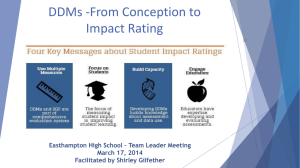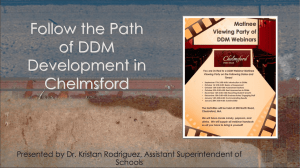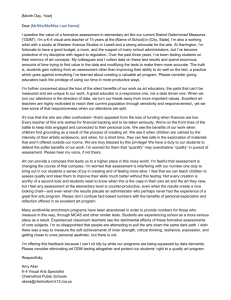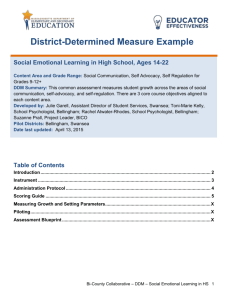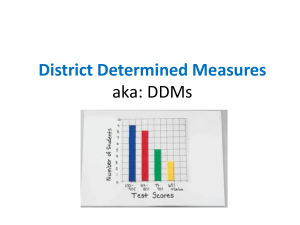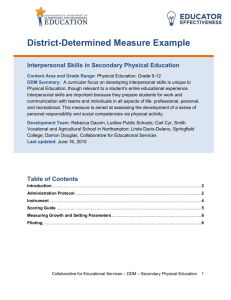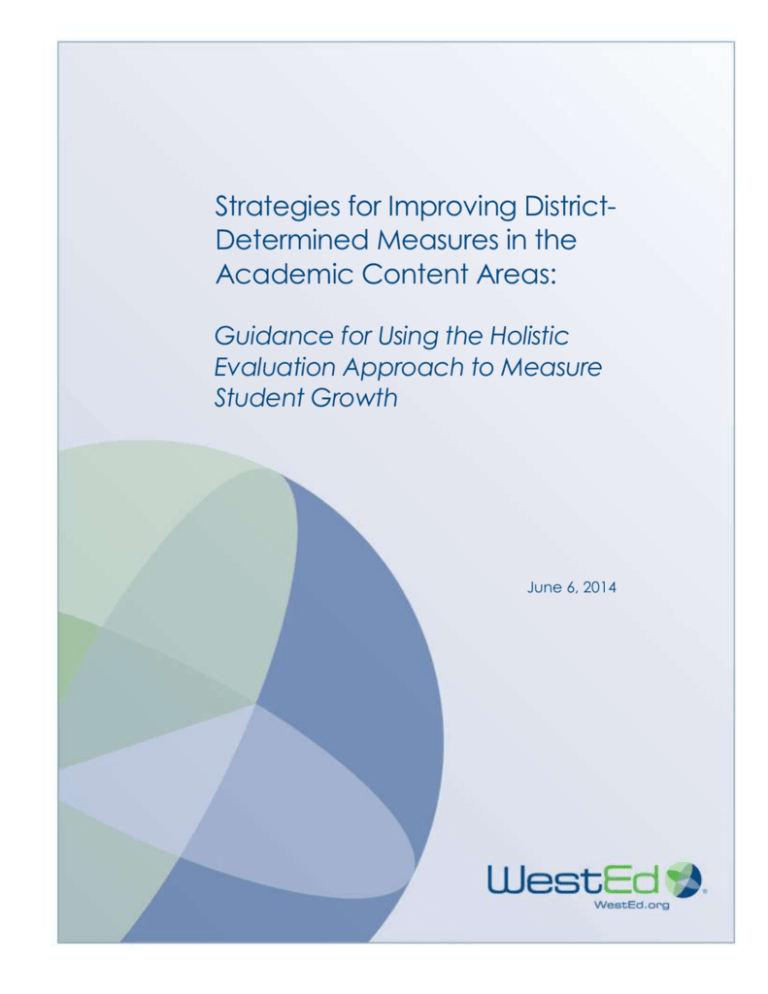
Strategies for Improving DistrictDetermined Measures in the
Academic Content Areas:
Guidance for Using the Holistic
Evaluation Approach to Measure
Student Growth
June 6, 2014
WestEd — a national nonpartisan, nonprofit research, development,
and service agency — works with education and other communities
to promote excellence, achieve equity, and improve learning for
children, youth, and adults. WestEd has 17 offices nationwide, from
Washington and Boston to Arizona and California, with its
headquarters in San Francisco. For more information about WestEd,
visit WestEd.org; call 415.565.3000 or, toll-free, (877) 4-WestEd; or write:
WestEd / 730 Harrison Street / San Francisco, CA 94107-1242.
© 2014 WestEd. All rights reserved.
Table of Contents
Introduction: Purpose of This Guidance Document
i
Section I. Using the Holistic Evaluation Approach to Measure Student
Growth with an Emerging DDM
1
Section II. Example Assessment #1, Using the Holistic Evaluation
Approach to Measure Student Growth
4
Section III. Suggestions for Refining Example Assessment #1to Ensure
Usefulness as a DDM
21
Section IV. Example Assessment #2, Using the Holistic Evaluation
Approach to Measure Student Growth
24
Section V. Suggestions for Refining Example Assessment #2 to Ensure
Usefulness as a DDM
27
Appendix A: Key ESE-Developed Resources to Support Districts with
Implementing DDMs that Effectively Measure Student Growth
29
Appendix B: Recommended External Resources on Measuring
Student Growth: Guidance from the Research and Measurement
Communities
32
Introduction: Purpose of This Guidance Document
Educators and administrators engaging in the selection and/or development of districtdetermined measures (DDMs) have been challenged with answering a key question about their
emerging DDMs: Does this measure detect some type of change in performance that can be
attributed to student growth? In a key resource developed to support districts with this
challenge, 1 the Massachusetts Department of Elementary and Secondary Education (ESE)
explains why it is so important that a DDM measure growth:
Students come to school each year with a wide range of prior academic achievement and therefore begin
their next year of instruction with varying levels of readiness to access the curriculum, a situation that is
beyond the control of the educator assigned to teach them. Measuring educators’ effectiveness solely by
the achievement level of their students cannot account for these prior conditions. By comparison,
measuring growth can help level the playing field. Improvement in student performance is a more
meaningful and fair basis for determining the trends and patterns that will yield the educator’s rating of
impact on student learning, growth, and achievement. (p. 8)
One strategy for supporting DDM developers in Commonwealth districts with this challenge is
to provide concrete examples of open-source, locally developed assessments that are useful for
the purpose of measuring student growth. The aim of sharing a sample of promising DDMs is to
stimulate further discussion about how, with a few strategic changes, existing assessments may
be adapted for use as DDMs. According to ESE, the strongest DDMs will emerge from districts
that have engaged in systematic study of the appropriateness and usefulness of their
assessments specifically for determining what students have learned from their educators
during a course of instruction.
A number of approaches to measuring growth that are described in a key ESE-developed
resource, Technical Guide B, do not require complex psychometric methods or statistical
computations.2 Each of these approaches has unique strengths and limitations. Many
measures can be adapted to a variety of approaches to measuring growth, so decision-makers
will want to use their professional judgment in weighing the pros and cons of each, considering
competing goals and determining the approaches best suited for their contexts.
This document is intended to support those educators and administrators who are considering
a holistic evaluation approach to examining growth with their locally developed assessments.
1
Massachusetts Model System for Educator Evaluation, Part VII: Rating Educator Impact on Student Learning Using
District-Determined Measures of Student Learning, Growth, and Achievement.
2
Companion documents have been developed that highlight three other common approaches to measuring
growth: (a) a pre-test/post-test approach; (b) a repeated measures approach; and (c) a post-test only approach.
WestEd_MA DDM Guidance for Academic Content Areas_Holistic Evaluation Approach
i
It includes the following:
key resources developed by ESE that offer guidance for monitoring the technical quality
of DDMs and for selecting a reasonable approach to measuring growth;
a summary of the strengths and limitations of the holistic evaluation approach to
measuring student growth;
sample assessments submitted by Commonwealth districts, with suggestions for how
the developers might refine each measure for use as a DDM; and
information about a number of external resources that educators and administrators
may find helpful if they elect to pursue a holistic evaluation approach.
It is hoped that this guidance document will help district personnel transform strong locally
developed measures of achievement and/or performance into promising DDMs that are
particularly effective in evaluating student growth.
WestEd_MA DDM Guidance for Academic Content Areas_Holistic Evaluation Approach
ii
Section I. Using the Holistic Evaluation Approach to Measure
Student Growth with an Emerging DDM
Conducting a holistic evaluation is a
relatively new approach for examining
student growth. While using rubrics is not
new for most districts, few have
developed or used a rubric specifically
designed to measure growth rather than
performance at one point in time.
Key ESE-Developed Resources to Support Districts
with Implementing DDMs that Effectively Measure
Student Growth
Technical Guide A (see especially pp. 25–29, 32, 34)
Technical Guide B (see especially pp. 6–7 and 11–20
and Appendix B)
Assessment Quality Checklist and Tracking Tool
A holistic evaluation is based on a review
Using Current Assessments in District-Determined
Measures: Leveraging the Curriculum-Embedded
of a collection of student work samples
Performance Assessments from the Model
gathered systematically over a sustained
Curriculum Units (see especially pp. 2–3, 6–8,
period of time. The collection of student
and 11)
work is then scored using a growth rubric,
Webinar Series #2 (slides 21–41 and 44–53), #5
(slides 20–27 and 32), #6 (slides 10–16), #7 (slides
holistically, across all work samples. This
11–12, 25–32, and 34), and #9 (slides 25–29)
approach is typically associated with
Implementation Brief: Scoring and Setting
nontraditional measures such as a set of
Parameters
on-demand performance activities/
demonstrations, portfolios, and
observation-based measures (observing behaviors or actions at key intervals and providing an
overall rating).
This approach has a number of strengths and limitations, based on guidance from experts in the
educational research and measurement communities. These are summarized in Table 1.3
3
See Appendix B for research- and measurement-based resources for the holistic evaluation approach.
WestEd_MA DDM Guidance for Academic Content Areas_Holistic Evaluation Approach
1
Table 1. Strengths and Limitations of the Holistic Evaluation Approach to Measure Student
Growth
Strengths
Limitations
Creates an opportunity to evaluate students’
Can be time-consuming to administer. Requires time
changing proficiency in performing complex tasks that
to observe a wide range of performances, to allow for
have real-world relevance.
development of meaningful rubrics.
Scoring rubric can be designed to combine the
processes of scoring student work, determining
growth, and setting parameters (high, moderate, and
low) for growth.
Use of a growth rubric can address important validity
concerns raised by scoring performance assessments
individually and then computing a growth score from
the individual scores.
May be better able to show growth along a wide
spectrum, as it allows the scorer to consistently
identify growth in student work that may have very
different strengths and weaknesses. For example, it is
useful when the students in a particular grade,
subject, or course have varied levels of ability but are
working on a common task.
Useful for measuring complex skills (e.g., reasoning),
performing multi-step tasks, or analyzing work
products that require considerable interpretation
when being evaluated.
Rubrics are a communication tool. They make
learning expectations and evaluation criteria explicit
and can be used to help students get a clear vision of
the task and the learning goals to which the task is
linked.
Illuminates where students started and how an
educator helped them grow.
Standardized administration conditions (when? how
many elements? who chooses the elements?) must
be enforced.
Requires expertise to develop an effective holistic
rubric designed explicitly for the purpose of
measuring growth. Setting the criteria on which
students will be judged and defining those criteria
operationally, in the form of a useful scoring rubric,
are also challenging.
Can be time-consuming to score. Also requires
training and calibration to ensure consistent scoring
against the rubric (inter-rater reliability challenges).
Must ensure that products and/or behaviors
observed are directly linked to what was taught
(curriculum embedded).
Different performance levels should be linked
systematically to the development of expertise.
Educators sharing a common DDM should reach
agreement on the types of evidence/behaviors
associated with performance at different levels.
Increasing the number of elements or tasks can
improve the reliability of scores obtained but also
adds to the time and expense involved in
administering and scoring.
Other Considerations
Districts interested in using the holistic evaluation approach also may want to attend to the
following considerations:
Rubrics should include detailed descriptions of what growth looks like at each
performance level.
Evaluation criteria should be specific enough to capture the most essential ingredients
of the skill being measured, but not so detailed as to create an undue burden for scorers
in terms of length. The criteria should help educators distinguish among students’
performances but should not be overwhelming.
Rubrics are most effective when they reflect the intended targets of learning and clarify
the important dimensions of each target.
WestEd_MA DDM Guidance for Academic Content Areas_Holistic Evaluation Approach
2
Development of performance level descriptors will be an easier task if samples of actual
student work are considered and those that best match various performance levels are
identified. The characteristics of each can then be captured in the descriptors.
Acceptable levels of agreement between raters can be established through the use of
anchor papers and other methods for calibrating scores.
It may be more efficient to borrow a strong growth rubric that already exists and adapt
it for use in this context.
To maintain scoring integrity, educators can arrange for peers to score one another’s
sets of portfolios or they can elect to use an alternative process involving external
raters.
WestEd_MA DDM Guidance for Academic Content Areas_Holistic Evaluation Approach
3
Section II. Example Assessment #1, Using the Holistic
Evaluation Approach to Measure Student Growth
The following portfolio assessment was submitted by a Commonwealth educator who adapted
an existing measure for use as a DDM. For more information about the assessment, please
contact Todd Wallingford at twallingford@hudson.k12.ma.us.
Locally Developed Assessment Well Suited for Use as a DDM
Submitted by: Todd Wallingford, Educator, Hudson Public School District
Course/Grade: English Language Arts (ELA) and Social Studies, Grades 9–12
Assessment Name: Hudson High School Portfolio Assessment
Item Type: Portfolio and Scoring Rubric
Description: This is a portfolio assessment designed to help students in ELA and social studies classrooms
reflect on what they have learned over time and to help them set personal learning goals each semester. It is
intended to demonstrate to educators the progress that students have made toward achieving specific learning
expectations. Students are asked to reflect on their own academic growth and describe how they met personal
goals on the pathway to meeting each learning expectation. They also submit an action plan for the following
school year, including personal goals for the next year and how the student intends to accomplish the goals.
These artifacts, reflections, and statements of academic goals are shared with students’ educators in
subsequent courses.
Students select the work samples (reports, diagrams, photographs, artwork, videos, etc.) that are included in
their portfolios. They are expected to be strategic during the selection process, to ensure that they have
submitted different types of evidence of their academic growth. Students choose artifacts that demonstrate
their progress toward mastering learning expectations in the following domains: collaboration, communication,
creativity, critical thinking, and independence. On an ongoing basis, they upload their selected artifacts to an
electronic site. Educators can access the documents there, and score the accumulated artifacts at key points in
the semester or year.
When the developers of this tool began their work, they envisioned a common assessment process that could
be used in a variety of courses by different educators to examine student growth. They also were united in
their commitment to promoting schoolwide literacy and technology skills. They viewed a thoughtful portfolio
assessment as an ideal way to help them reach important school improvement goals and enable students to
take greater responsibility for their own academic growth.
This measure has been adapted for use in dozens of required (e.g., American and World Literature, U.S. and
World History, and Economics) and elective (e.g., Creative Writing, Western Civilization, Journalism, and
Psychology) courses. The results from the portfolio assessment are an important consideration when educators
calculate final grades for their students.
WestEd_MA DDM Guidance for Academic Content Areas_Holistic Evaluation Approach
4
Locally Developed Assessment Well Suited for Use as a DDM
Submitted by: Todd Wallingford, Educator, Hudson Public School District
(continued from previous page)
Educators score the portfolios using a common rubric with four performance levels: Exemplary, Proficient,
Satisfactory, and Needs Improvement. Using performance level descriptors, educators evaluate each portfolio
in relation to the degree to which the student demonstrated growth in each of the following areas: following
directions, thinking strategically and creatively in selecting artifacts, using technology skills to submit the
artifacts in a timely manner, organizing the artifacts meaningfully, and completing reflection activities
effectively using knowledge of grammar, writing skills, and introspection.
WestEd_MA DDM Guidance for Academic Content Areas_Holistic Evaluation Approach
5
Hudson High School
Portfolio Handbook
English Language Arts and Social Studies
Table of Contents:
1. Statement of Purpose
7
2. Vision and Beliefs
7
3. Setting Up/Accessing an HHS Student Google Account
7
4. How to Create a Google Site Portfolio
8
5. Personalizing Your Site
16
6. Creating Course-Specific Pages
16
7. Portfolio Expectations
17
a. Introduction
17
b. Course-Level Learning Expectation Pages
17
List of Five Learning Expectations
17
c. Course-Level Final Reflection Page
19
d. Choosing Appropriate Artifacts
19
e. Letter to Next Year’s Teacher
19
8. Grading Criteria
WestEd_MA DDM Guidance for Academic Content Areas_Holistic Evaluation Approach
19
6
1. Statement of Purpose: Portfolios will provide a forum for students to reflect on their
own academic growth and achievement over time and set specific personal learning
goals for the future. Each student will choose samples of their work (“artifacts”) and
explain how they demonstrate progress toward the five English and Social Studies
Learning Expectations. The portfolio serves as an overall skill assessment and is
therefore calculated as a portion of each course’s final grade.
2. Vision and Beliefs: Student portfolios provide:
a. a way to document student learning over time.
b. an opportunity to examine the features of quality work and instill pride in
achieving improvement over time.
c. an opportunity for students to engage in conversations about their learning with
their teachers, and with others who may view their portfolios.
d. a way for students to determine their own academic goals based on evidence
and criteria, and to make plans to achieve those goals.
e. an opportunity for students to take ownership of their learning and reflect on
their learning process.
3. Setting Up/Accessing an HHS Student Google Account
a. Using your web browser, go to www.google.com.
b. In the top right-hand corner, click “Sign In”.
If you have already created your HHS Student Google Account, simply sign in
using your username (e.g., JQSchmoe2016@student.hudson.k12.ma.us) and
password.
If you cannot remember your password, you will need to seek
assistance through the technology department to reset.
If you have not already created your HHS Student Google Account, use the
following instructions:
Enter your username (e.g.,
JQSchmoe2016@student.hudson.k12.ma.us).
Enter the following password: Hudson1234
Follow the program’s instructions to complete setup.
WestEd_MA DDM Guidance for Academic Content Areas_Holistic Evaluation Approach
7
4. How to Create a Google Site Portfolio (from school)
WestEd_MA DDM Guidance for Academic Content Areas_Holistic Evaluation Approach
8
WestEd_MA DDM Guidance for Academic Content Areas_Holistic Evaluation Approach
9
HHS Portfolio
WestEd_MA DDM Guidance for Academic Content Areas_Holistic Evaluation Approach
10
WestEd_MA DDM Guidance for Academic Content Areas_Holistic Evaluation Approach
11
WestEd_MA DDM Guidance for Academic Content Areas_Holistic Evaluation Approach
12
WestEd_MA DDM Guidance for Academic Content Areas_Holistic Evaluation Approach
13
WestEd_MA DDM Guidance for Academic Content Areas_Holistic Evaluation Approach
14
How to log in to your site from home
WestEd_MA DDM Guidance for Academic Content Areas_Holistic Evaluation Approach
15
Then click on your site and get working!
5. Personalizing Your Site: Once you have created your site, feel free to be creative. You
can alter the design to better demonstrate who you are as a student and a person.
a. Go to the main page of your portfolio. Click the “More” button on the top right
portion of the webpage. Then click on “Manage Site”. On the left-hand side of
the page, scroll down until you see “Site Layout”, “Colors and Fonts”, and
“Themes”. These options will allow you to do several things that personalize
your site. It is up to you!
b. You can also embed a variety of media that personalize your site. (Keep in mind
that this site is for academic purposes and is designed to demonstrate your
academic and personal growth.) In order to do this, click the pen icon on the top
right to enter edit mode. Then use the insert function to embed an object. Do
not forget to save your changes!
6. Creating Course-Specific Pages: These pages will be added at the discretion of your
teacher and will be unique to the class you are presently taking. For example, English
teachers may choose to add a page that documents independent reading, while Social
Studies teachers may add a page that documents current-event presentations. These
expectations will be communicated to you by your classroom teacher.
a. In order to add a new page, click the page icon on the top right portion of the
webpage. Next, name your new page according to the teacher’s instructions.
Then identify what type of page it will be (webpage, announcement, file cabinet,
or list). After that, select a location for your new page. This new page should be
placed under the course page. Finally, click “Create.”
WestEd_MA DDM Guidance for Academic Content Areas_Holistic Evaluation Approach
16
7. Portfolio Expectations: Understanding what is required for each section.
a. Introduction
This is the home page of the Google Site. Students will use this page to
introduce themselves to the reader, both personally and academically.
Students should also demonstrate, metacognitively, what they know about
themselves as learners. In addition to this narrative, students may use
creative freedom to express who they are (including artwork, poetry, etc.).
Template structure:
Hello! My name is ____________ and I am presently a/an _______________
grader at Hudson High School.
Write a paragraph here that explains the following:
1. Your interests
2. Your favorite subject(s) and why
3. The way you learn best (i.e., what did you or the teacher do in the class
you learned/enjoyed the most?)
4. What you hope to do the same and what you hope to do differently in
school this year
b. Course-Level Learning Expectation Pages: These “mini-blog” pages provide
students with an electronic journaling space to document academic growth as it
relates to a particular Learning Expectation. Students should regularly reflect
upon specific assignments highlighting progress related to each Learning
Expectation.
Here is a list of the Five Learning Expectations, with guiding questions to prompt
thinking regarding reflections:
Collaboration: Working together with two or more people to achieve or
produce something.
Guiding questions to consider when reflecting on your learning:
1. How well do I work with others?
2. What role did I play in the group?
3. How did I help my group achieve our goal? How could I have been more
helpful?
4. How did I respond to feedback from my peers, and/or how did I give
feedback to them?
5. How have I grown as a collaborator? or How do I plan to use this
experience to help me become a better collaborator in the future?
Communication Expressing your thoughts and opinions through writing,
speech, or images in a clear way that other people can understand.
WestEd_MA DDM Guidance for Academic Content Areas_Holistic Evaluation Approach
17
Guiding questions to consider when reflecting on your learning:
1. How effectively did I communicate my ideas or thoughts in this
activity/assignment?
2. Through which ways did I express my ideas? (Was this an oral
presentation, written report, poster, etc.?)
3. How did I communicate any problems I had throughout the process of
completing this activity/assignment?
4. How have I shown growth as a communicator through this
activity/assignment? or How could I have communicated better?
Creativity: Involving the use of imagination to produce new ideas.
Guiding questions to consider when reflecting on your learning:
1. How did I express my ideas in a creative way in this activity/assignment?
2. How did I use my imagination to implement my own original ideas?
3. How have I grown as a creative learner? or How can I use this experience
to become more creative in the future?
Critical Thinking: Making careful judgment on an idea or topic, using multiple
pieces of evidence and perspectives, including those from your own personal
experiences.
Guiding questions to consider as you write your reflections:
1. How did I gather my evidence?
2. How did I demonstrate my analytic skills? or How did I prove my
argument?
3. What issues did I encounter when analyzing my evidence (proofs)?
4. How have I grown in my ability to think critically (analyze evidence)? or
How can I use this activity/assignment to think critically in the future?
5. What connections can I make from this piece to other areas of my
learning (e.g., science, math, art, etc.)?
Independence: Setting goals, taking action toward those goals, and
overcoming obstacles without waiting for someone to tell you what to do.
Guiding questions to consider when reflecting on your learning:
1. How did I set goals and monitor my progress in order to complete this
project?
2. How did I take initiative to overcome challenges and solve problems I
faced?
3. How did I manage my time well in order to meet deadlines?
4. How did my attitude contribute to my results?
WestEd_MA DDM Guidance for Academic Content Areas_Holistic Evaluation Approach
18
c. Course-Level Final Reflection Page: Students will use this page to complete a
final and cumulative course reflection that analyzes academic growth toward
meeting the Learning Expectations. Each reflection should contain the student’s
personal thoughts on how he or she met his or her academic goals as they relate
to the associated Learning Expectation. Reflections should identify and explain
how the related artifact(s) demonstrates that growth. Each reflection should be
a thorough and honest examination of the student’s own learning.
d. Choosing Appropriate Artifacts: How to choose appropriate evidence that
demonstrates academic growth.
Progress toward meeting each Learning Expectation should be
demonstrated with at least one artifact, although providing multiple
artifacts is preferable so that students can demonstrate growth over time.
Artifacts should be a demonstration of student work (e.g., papers, videos,
artwork). Rubrics are welcomed, but are incomplete demonstrations of
academic progress.
Artifacts should be embedded into the final reflection page under each
reflection. It is vital that all embedded evidence is properly shared with
viewers in order to receive credit. Evidence can also be attached to the
bottom of the final reflection page.
e. Letter to Next Year’s Teacher: Students will use this page to critically analyze
overall academic progress and establish a comprehensive yet appropriate action
plan for the following school year. The action plan should identify specific and
progressive academic goals related to each of the five learning expectations. It
should also explain how the student plans on accomplishing each goal.
2. Grading Criteria
a. Portfolios will be worth 10–20% of the final course grade. The specific
percentage will be set at each course/grade level.
b. Teachers will use the rubric on the next page as a general guide for assessing
student work.
WestEd_MA DDM Guidance for Academic Content Areas_Holistic Evaluation Approach
19
Grading Rubric
Criteria
Exemplary
Proficient
Satisfactory
Needs Improvement
Met
Contains all required
Requirements content and then some.
(weight) %
Contains all required
content.
Nearly all parts included. Missing significant
pieces.
Organization
(weight) %
Portfolio organization is
exceptional, ensuring
ease of use. Appearance
is professional and
technology is mastered.
Portfolio organization is
strong, ensuring ease of
use for the most part.
Appearance is
professional and
technology is mostly
mastered.
Portfolio organization is
satisfactory. Some
aspects confuse the
viewer. Appearance
could use some
improvement. There is
obvious discomfort with
the technology.
Portfolio organization
needs work. The
viewer has significant
difficulty finding
required elements.
Appearance is lacking
and technology is not
understood.
Creativity
(weight) %
Demonstrates
outstanding creative
approach and design
throughout.
Strong creative effort
throughout.
Basic creative effort
throughout.
No attempt at
presenting work in an
interesting manner.
Introduction
(weight) %
The introduction is
informative and
reflective, providing the
viewer tremendous
insight on the learner.
The introduction is
informative and
somewhat reflective,
providing the viewer
with some insight on the
learner.
The introduction is
informative, but lacks
reflection, providing the
viewer with limited
insight on the learner.
The introduction is
neither informative nor
reflective, providing
the viewer with little
insight on the learner.
Reflections
(weight) %
Reflections are
completely honest and
thoughtful assessments
of academic progress.
Reflections are mostly
honest and thoughtful
assessments of
academic progress.
Reflections are mostly
topical assessments of
academic progress and
show little thought.
Reflections are basic
assessments of
academic progress and
show no thoughtful
reflection.
Artifacts
(weight) %
Artifacts are completely
relevant and accurately
demonstrate academic
performance as stated in
reflections.
Artifacts are relevant
and usually demonstrate
academic performance
as stated in reflections.
Artifacts are somewhat
relevant and vaguely
demonstrate academic
performance as stated
in reflections.
Artifacts are not
relevant and fail to
demonstrate academic
performance as stated
in reflections.
Letter to Next
Year’s
Teacher
(weight) %
The letter provides
critical analysis of
academic progress and
establishes a
comprehensive yet
appropriate action plan
for the following year.
The letter provides
analysis of academic
progress and establishes
a decent action plan for
the following year.
The letter provides
some analysis of
academic progress and
establishes a basic
action plan for the
following year.
The letter provides
little critical analysis of
academic progress and
fails to establish an
action plan for the
following year.
Spelling and
grammatical errors are
insignificant and do not
impede the reader.
Spelling and
grammatical errors
make the product
difficult to read.
Grammar
(weight) %
-----------
-----------
WestEd_MA DDM Guidance for Academic Content Areas_Holistic Evaluation Approach
20
Section III. Suggestions for Refining Example Assessment #1to
Ensure Usefulness as a DDM
This example assessment, which shows great promise for use as a DDM, is unique in a number
of ways. First, it was developed specifically for the purpose of measuring student growth using
a rubric that, with only a little tweaking, will support educators with decision-making about low,
moderate, and high growth. Second, it is linked to other key initiatives in its district that are
seeking to improve literacy skills across students in all ELA and social studies classrooms,
increase students’ capacity to use technology skills strategically to accomplish tasks, and
promote students’ greater investment in their own academic growth. Third, it can easily be
adapted to different grades and subjects, which makes it ideal for districts seeking measures
that promote comparability across grades, subjects, and courses.
Suggestions for refining this assessment are shared to illustrate some of the possible ways in
which districts might, with slight modification, use existing assessments as DDMs.
Suggestion 1: Develop rubrics that are designed to measure student growth. Districts seeking
to use a holistic evaluation approach with a promising DDM will want to develop rubrics that
include descriptions of performance that are intended to capture what high, moderate, and low
growth look like for each criterion (e.g., grammar). For example, students at Hudson High
School who are completing this high-quality portfolio assessment are asked to choose work
from across the year that demonstrates how they met goals they set for themselves during the
previous course or school year. However, as currently designed, the rubric evaluates a final
product, rather than evaluating changes in a student’s ability to organize, create, reflect, and/or
use approved writing techniques. A growth rubric, on the other hand, would ask the rater to
look for evidence of knowledge or skill that was not demonstrated in earlier work but is
demonstrated in later work.
Admittedly, this can be a very challenging task. Districts that are developing new growth rubrics
might use this development process as an opportunity to reach agreement on the key elements
of growth that are most closely linked to their instruction. They can craft common language
that can be used across a variety of classrooms, by creating a continuum of learning
benchmarks and noting those changes in knowledge or skills that are most representative of
low, moderate, and high growth for each criterion (e.g., appropriate use of domain-specific
technical terms).4 Educators seeking to use a strong existing summative rubric as a DDM might
consider changing their approach to measuring growth, rather than modifying the rubric itself.
For example, they could compare a student’s end-of-year or end-of-course rating for each
4
See Section IV for sample language that might appear on a rubric designed to measure growth.
WestEd_MA DDM Guidance for Academic Content Areas_Holistic Evaluation Approach
21
criterion with that student’s ratings from the school year or course that immediately preceded
it. They will be looking for evidence that a previous year’s rating changed over time—e.g.,
moved from Needs Improvement to Satisfactory or from Proficient to Exemplary. For each
criterion on which a student demonstrated growth, the student would receive a point. A
composite score could then be generated by summing the points earned across all criteria.
Suggestion 2: Closely examine degree of alignment to the curriculum. Technical Guide B states
that the first priority for selecting a DDM is: “Is the measure aligned to valued content?” (p. 5).
Districts will want to collect different types of evidence to support their claims that a holistic
evaluation is instructionally sensitive—i.e., that it measures learning of content that is closely
linked to what is taught. For example, if the goal is to assess creativity with the Hudson High
School Portfolio Assessment, are students learning how to be creative in class? In what ways do
educators expect to see change in a student’s creativity due to the class experience? Are
students receiving instruction in how to select artifacts? With the current example, a district
might decide that a student’s ability to reflect on his or her own growth and to write a
coherent, grammatically correct letter are the criteria most closely linked to instruction and
should thus be the focus for one of its DDMs.
Since students are being evaluated on multiple criteria, districts may want to consider
strategies for ensuring that each criterion is fairly represented in their growth estimates. By
assigning a weighted score to each individual criterion, an overall (holistic) score, which takes
into consideration the relative importance of each criterion in terms of instructional sensitivity,
can be assigned. When setting parameters for high, moderate, and low growth based on the
total score, the district can then explain to stakeholders that those criteria that are most closely
linked to valued content, and hence to instruction, contributed relatively greater weight to
students’ growth scores.
Suggestion 3: Collect evidence about the consistency of scoring. Districts using a holistic
evaluation approach will be looking for evidence that the portfolio-, performance-, or projectbased assessment can be scored reliably across educators (inter-rater agreement or reliability)
and over time (intra-rater reliability). To do so, they may want to consider collecting evidence
about the degree to which (a) two educators scoring the same portfolio, performance, or
project apply the rubric in a similar manner and assign the same rating, and (b) one educator
applies the rubric consistently over time, assigning the same rating to one student who submits,
performs, or presents work products at two closely spaced time points. They can use this
information to improve training procedures and put in place periodic checks on scorer
calibration.
Districts may find it useful to begin collecting examples of student work that raters agree are
representative of each level of performance for each criterion. These examples can be very
WestEd_MA DDM Guidance for Academic Content Areas_Holistic Evaluation Approach
22
helpful to educators when they are deciding if a sample of student work should be rated as
exemplary, proficient, satisfactory, or needs improvement as outlined in the Hudson scoring
rubric. If they are strategically selected and replaced when an even stronger sample of student
work emerges, use of representative examples can support educators in making the finely
grained distinctions about student growth that are characteristic of a strong DDM.
WestEd_MA DDM Guidance for Academic Content Areas_Holistic Evaluation Approach
23
Section IV. Example Assessment #2, Using the Holistic
Evaluation Approach to Measure Student Growth
A second example assessment, submitted by a former Commonwealth educator, is presented
on the following pages. These tile-pattern problems were developed by College Preparatory
Mathematics (CPM) and are reprinted here with its permission. For more information, please
go to CPM’s website at http://www.cpm.org/.
Locally Developed Assessment Well-Suited for Use as a DDM
Submitted by: Leah Tuckman, Math Specialist, Greater Boston District and School Assistance
Center
Course/Grade: Grade 8 Mathematics and Algebra I
Assessment Name: CPM Math Assessments
Item Type: Constructed Response and Scoring Rubric
Description: This mathematics specialist submitted two task-based assessments developed by CPM that are
intended to be administered in grade 8 mathematics and in Algebra I. Each measure can be administered at the
beginning and end of the course or school year.
The measure for grade 8 directs students to look at a diagram with a series of patterns. Students are asked to
create as many more representations of the linear function displayed as possible and to use different colors to
help connect the representations. The measure for Algebra I has the same directions, but the pattern is
somewhat more complex. Both measures are aligned to the Massachusetts Mathematics Curriculum
Framework for grade 8 mathematics, and the standards assessed are specified.
WestEd_MA DDM Guidance for Academic Content Areas_Holistic Evaluation Approach
24
Grade 8 Mathematics DDM5
[College Preparatory Mathematics]
Look at the pattern below. With the assumption that this pattern continues, complete and analyze the
representation below and create as many more representations of this linear function as possible.
Make sure to use different colors to help connect the representations together.
Standards Assessed: 8.EE.6, 8.F.1, 8.F.2, 8.F.3, 8.F.4, 8.F.5
5
Dietiker, L. (2013). Core Connections, Course 3 (2nd ed.). Sacramento, CA: CPM Educational Program. Copyright ©
2013 CPM Educational Program. All rights reserved.
WestEd_MA DDM Guidance for Academic Content Areas_Holistic Evaluation Approach
25
Algebra DDM6
[College Preparatory Mathematics]
Look at the pattern below. With the assumption that this pattern continues, complete and analyze the
representation below and create as many more representations of this linear function as possible.
Make sure to use different colors to help connect the representations together.
Standards Assessed: A.SSE.1, A.SSE.2, A.SSE.3, A.CED.1, A.CED.2, A.REI.4, F.IF.4, F.IF.5, F.IF.7a, F.IF.8a,
F.MA.8.c
6
Dietiker, L. (2013). Core Connections, Course 3 (2nd ed.). Sacramento, CA: CPM Educational Program. Copyright ©
2013 CPM Educational Program. All rights reserved.
WestEd_MA DDM Guidance for Academic Content Areas_Holistic Evaluation Approach
26
Section V. Suggestions for Refining Example Assessment #2
to Ensure Usefulness as a DDM
Suggestion 1. Develop a rubric that supports decision-making about low, moderate, and high
growth. In order to use assessments like this example as a DDM, districts will need to
determine how best to measure student growth using that tool. One strategy for doing so is to
use a rubric to guide teachers in conducting a holistic evaluation of growth. As shown in Table 2
on the following page, a rubric designed to evaluate change in performance over time (i.e.,
from beginning of the year to the end of the year) can help educators draw conclusions about
specific areas of growth and assign an overall rating for student growth. Note that the language
used in the performance descriptors at each level is intended to capture change over time in
students’ ability to respond to a mathematical task. The developer includes words such as
“improvement” and gives credit to students who make key corrections to their earlier work
when completing the same task at the end of the year.
The goal for this evaluation is to look for an overall increase in the number, accuracy, and
connections between representations on the end-of-year or end-of-course task as compared to
earlier work samples. In order to receive a rating of high growth, students must show significant
improvement in all three skills. Students rated as demonstrating moderate or low growth also
must show improvement in number, accuracy, and connections between representations,
though at a relatively lower level. For example, one of the criteria required for students to
receive a rating of high growth is that they must show “significant improvement” in graphical
representation, while students assigned ratings of moderate and low growth will show “much
improvement” or “little improvement” in graphical representation, respectively.
WestEd_MA DDM Guidance for Academic Content Areas_Holistic Evaluation Approach
27
Table 2. Growth Rubric for Holistic Evaluation: Increasing the Number, Accuracy, and
Connections Between Representations
No Growth
Low Growth
Moderate Growth
High Growth
One or two are true:
One or two are true:
Two are true:
All are true:
There is no
improvement in
graphical
representation of the
function across
versions (appropriate
scaling/labeling/
details/intercepts/key)
There is little
improvement in
graphical
representation of the
function across
versions (appropriate
scaling/labeling/
details/intercepts/key)
There is much
improvement in
graphical
representation of the
function across
versions (appropriate
scaling/labeling/
details/intercepts/key)
There is significant
improvement in
graphical
representation of the
function across
versions (appropriate
scaling/labeling/
details/intercepts/key)
A few representations
are included, but
details are inaccurate
in future versions
Multiple
representations are
included, but
inaccurate details have
not been corrected in
future versions
Multiple
representations are
included, and details
have been corrected in
future versions
Multiple
representations are
included, and details
build upon previous
versions
There is a moderate
increase in
connections made
between the function
representations
There is a significant
increase in
connections made
between the function
representations
There is no increase in
connections made
between the function
representations
There is a small
increase in
connections made
between the function
representations
WestEd_MA DDM Guidance for Academic Content Areas_Holistic Evaluation Approach
28
Appendix A: Key ESE-Developed Resources to Support
Districts with Implementing DDMs that Effectively Measure
Student Growth
August 2012
Part VII, Massachusetts Model System for Educator Evaluation: Rating Educator Impact on
Student Learning Using District-Determined Measures of Student Learning
Overview of DDMs and related concepts. It will be most valuable for districts beginning to learn
about this work.
http://www.doe.mass.edu/edeval/model/PartVII.pdf
Monthly Since February 2013
Educator Evaluator e-Newsletter
Monthly newsletter designed to be a timely resource that provides key information, updates,
and answers to frequently asked questions.
http://www.doe.mass.edu/edeval/communications/newsletter/
March 2013
Introduction: District-Determined Measures and Assessment Literacy (Webinar Series #1)
ESE has developed a nine-part webinar series on DDMs and assessment literacy. This series is
targeted at district teams engaged in the work of identifying and selecting DDMs (e.g., districtand school-based curriculum and assessment leaders). Resources from these webinars include
the recorded webinar and materials from each session.
http://www.doe.mass.edu/edeval/ddm/webinar.html
April 2013
Basics of Assessment and Assessment Options (Webinar Series #2 and #3)
http://www.doe.mass.edu/edeval/ddm/webinar.html
Technical Guide A: Considerations Regarding District-Determined Measures
Designed to increase assessment literacy by introducing foundational assessment concepts. It
will be most valuable to districts interested in learning more about technical assessment
concepts.
http://www.doe.mass.edu/edeval/ddm/TechnicalGuide.pdf
WestEd_MA DDM Guidance for Academic Content Areas_Holistic Evaluation Approach
29
April 2013 (continued)
Assessment Quality Checklist and Tracking Tool
An interactive tool, built in Microsoft Excel, that organizes and catalogs information about
individual assessments into a districtwide tracker of all potential DDMs. It will be most valuable
to districts working to identify and select measures across the district.
http://www.doe.mass.edu/edeval/ddm/webinar/Quality-Tracking-Tool.xlsm
July 2013
Determining the Best Approach to District-Determined Measures (Webinar Series #4)
http://www.doe.mass.edu/edeval/ddm/webinar.html
DDM Technical Assistance and Networking Session I
ESE-hosted technical assistance and networking sessions intended to build on the Assessment
Literacy Webinar Series and provide participants an opportunity to engage with colleagues from
other districts around critical planning and implementation questions related to the piloting
and eventual implementation DDMs.
http://www.doe.mass.edu/edeval/ddm/webinar.html
August 2013
Measuring Student Growth and Piloting District-Determined Measures (Webinar Series #5)
http://www.doe.mass.edu/edeval/ddm/webinar.html
September 2013
Technical Guide B: Measuring Student Growth & Piloting District-Determined Measures
http://www.doe.mass.edu/edeval/ddm/TechnicalGuideB.pdf
DDM Technical Assistance and Networking Session II
http://www.doe.mass.edu/edeval/ddm/webinar.html
October 2013
Determining How to Integrate Assessments into Educator Evaluation: Developing Business Rules
and Engaging Staff (Webinar Series #6)
http://www.doe.mass.edu/edeval/ddm/webinar.html
Using Current Assessments in District-Determined Measures: Leveraging the CurriculumEmbedded Performance Assessments from the Model Curriculum Units
http://www.doe.mass.edu/edeval/ddm/UsingAssessments.pdf
WestEd_MA DDM Guidance for Academic Content Areas_Holistic Evaluation Approach
30
December 2013
Ramping Up for Next Year: Strategies for Using Current Assessments as DDMs (Webinar
Series #7)
http://www.doe.mass.edu/edeval/ddm/webinar.html
DDM Technical Assistance and Networking Session III
http://www.doe.mass.edu/edeval/ddm/webinar.html
January 2014
Communicating Results (Webinar Series #8)
http://www.doe.mass.edu/edeval/ddm/webinar.html
February 2014
Sustainability (Webinar Series #9)
http://www.doe.mass.edu/edeval/ddm/webinar.html
Implementation Brief: Scoring and Setting Parameters
http://www.doe.mass.edu/edeval/ddm/Scoring-ParameterSet.pdf
Implementation Brief: Investigating Fairness
http://www.doe.mass.edu/edeval/ddm/Fairness.pdf
Implementation Brief: Using Student Growth Percentiles
http://www.doe.mass.edu/edeval/ddm/GrowthPercentiles.pdf
March 2014
Implementation Brief: Indirect Measures and Specialized Instructional Support Personnel (SISP)
http://www.doe.mass.edu/edeval/ddm/IMSISP.pdf
April 2014
Implementation Brief: Administrators
http://www.doe.mass.edu/edeval/ddm/Admin.pdf
Implementation Brief: Considerations for English Language Learners
http://www.doe.mass.edu/edeval/ddm/ELLEducators.pdf
Implementation Brief: Considerations for Special Education
http://www.doe.mass.edu/edeval/ddm/SpecialEduEducators.pdf
WestEd_MA DDM Guidance for Academic Content Areas_Holistic Evaluation Approach
31
Appendix B: Recommended External Resources on
Measuring Student Growth: Guidance from the Research
and Measurement Communities
Table 2. Research- and Measurement-Based Resources for Holistic Evaluation Approach
Author(s)
Resource
Topics Addressed
Judy Arter, Pearson
Assessment Training
Institute
Creating & Recognizing Quality
Rubrics: A Study Guide (2009)
Recommendations for developing tools for
tracking student mastery of important learning
targets and planning the next steps in
instruction. Chapters 1 and 2 prescribe various
types of rubrics (holistic versus analytic) for
different purposes. Chapter 3 focuses on
general development guidelines. Also
describes characteristics of effective
performance tasks (Chapter 4) and how to
score them, using rubrics as tools.
Laura Goe, National
Comprehensive Center for
Teacher Quality (NCCTQ)
Measuring Teachers’
Contributions to Student
Learning Growth for Nontested
Grades and Subjects (2011)
The NCCTQ describes options for assessing
student learning growth for educators in
grades and subjects not targeted for state
standardized testing. See especially pp. 5–8
and 16–18.
Focus is on developing growth measures that
are aligned to valued content and are rigorous
and comparable across classrooms. Guiding
questions for examining feasibility also
provided.
Anders Jonsson and Gunilla
Svingby, Malmo University
The Use of Scoring Rubrics:
Reliability, Validity, and
Educational Consequences
(2007, Educational Research
Review, 2, 130–144)
Academic paper that presents findings from a
meta-analysis of research on use of rubrics
and their usefulness in judging complex
competencies and promoting learning. Issue of
inter-rater reliability is addressed.
Barbara Moskal and Jon
Leydens, Colorado School of
Mines
Scoring Rubric Development:
Validity and Reliability (2000,
Practical Assessment, Research
& Evaluation, 7[10])
User-friendly recommendations for ensuring
that various types of evidence are collected to
ensure rubric validity and reliability and ro
support continuous improvement.
Jim Popham, University of
California, Los Angeles
What’s Wrong—and What’s
Right—With Rubrics (1997,
Educational Leadership, 55(2),
72–75)
Discussion of the essential features of a rubric
(evaluative criteria for judging student
responses, definitions of performance at each
level, and scoring strategy) and how to avoid
common pitfalls in using and/or developing
each.
WestEd_MA DDM Guidance for Academic Content Areas_Holistic Evaluation Approach
32
Author(s)
Resource
Topics Addressed
Jennifer Steele, Laura
Hamilton, and Brian Stecher,
RAND
Incorporating Student
Performance Measures into
Teacher Evaluation Systems
(2010)
Provides guiding questions to help districts
select quality measures of student
performance. Strategies for addressing
challenges used in other jurisdictions are
highlighted. See especially pp. 8–9 and 23.
Dannelle Stevens and
Antonia Levi, Portland State
University
Introduction to Rubrics: An
Assessment Tool to Save
Grading Time, Convey Effective
Feedback, and Promote
Student Learning (2012)
Primer on rubric types and use of rubrics to
support teaching and learning. Includes
strategies for improving rubrics over time,
using feedback from students.
Tennessee Department of
Education
Tennessee Fine Arts Growth
Measures System
(Note: similar rubrics are being
developed for World
Languages and Physical
Education)
Designed to provide educators of music,
theater, visual arts, and dance with authentic
evaluations of what students know and can do
at the end of instruction. Educators collect
work samples over time, using a purposeful
sampling process, and evaluate them for
evidence of growth. Portfolios may be selfscored or scored by peer review. Measures
growth in four learning domains: perform,
create, respond, and connect.
National Center for Research
on Evaluation, Standards, &
Student Testing (CRESST), in
conjunction with Los Angeles
Unified School District
Writing Assessments and
Rubrics
Includes a set of sample performance tasks for
grades 2–9 that are aligned to the Common
Core State Standards. Intended to assess
writing skills and support writing instruction in
English language arts, science, and social
studies. Scoring manuals, rubrics, anchor
papers, and training papers are provided.
WestEd_MA DDM Guidance for Academic Content Areas_Holistic Evaluation Approach
33

